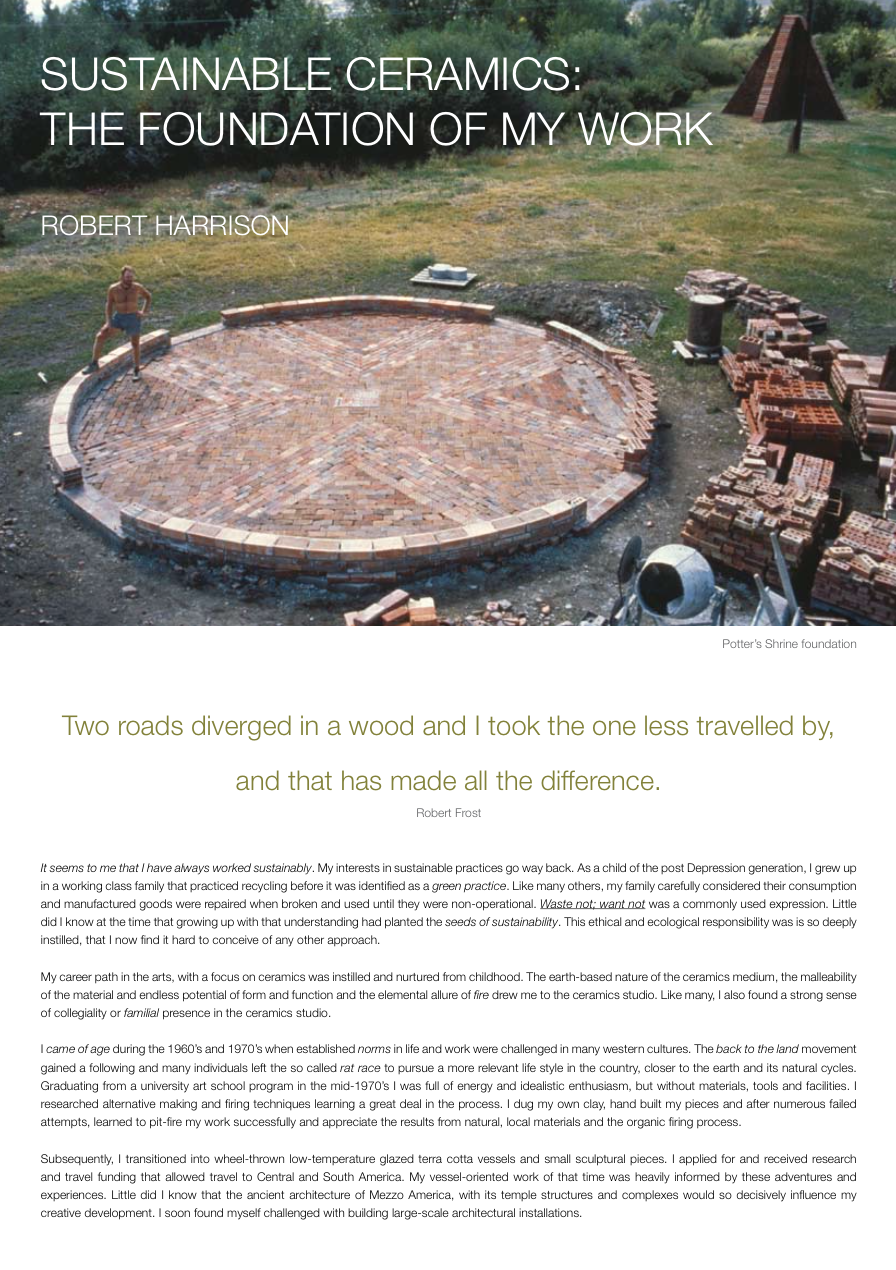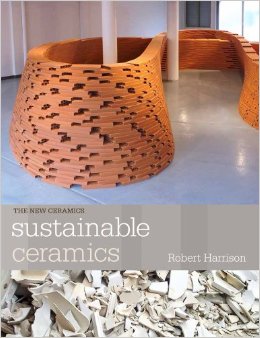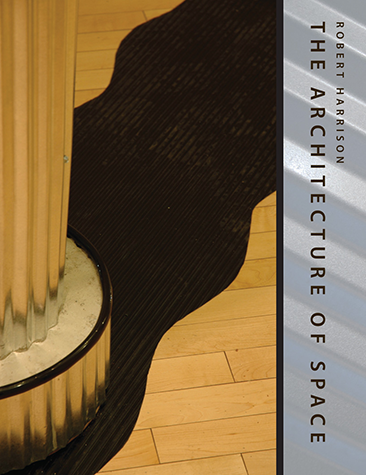Publications
Ceramics Ireland Magazine
Read the “Sustainable Ceramics: The Foundation of My Work” from Ceramics Ireland Magazine by clicking the link below.
Sustainable Ceramics
More and more artists are interested in producing work that is not only beautifully designed and produced, but is also environmentally friendly and socially responsible. In Sustainable Ceramics, pioneer Robert Harrison draws on more than four decades of making to present practical possibilities for ceramic artists.
This book covers all the factors to consider when going ‘green’, from fuels and alternative firing technology to energy-saving methods, sustainable ways to collect and use clay itself, and ways to deal with waste materials and save water. He suggests simple and achievable methods by which to reduce the carbon footprint of ceramic art, and offers examples throughout of practitioners who reclaim, reuse and recycle in their work.
Sustainable Ceramics is an essential resource for any ceramicist, studio or school wishing to reduce the impact of their practice on the environment.
This book will undoubtedly become the bible for the green movement within the ceramic arts. Not only does it provide great technical information (everything from best practices for kiln firings to imaginative reuse of ceramic materials to ergonomics for the sustainability of the ceramist’s body), it offers wide-ranging first-person accounts by leading artists who are already working sustainably in very creative ways. Robert Harrison is to be commended for his leadership in this field.
This book should be read by every potter and ceramic sculptor!
– Rick Newby
“Ceramics with all its inherent needs of making, materials, firing fuels and working space is certainly not a clean/green medium.”
A statement by Robert Harrison, author of the book ‘Sustainable Ceramics: a practical approach’, lays out immediately for anyone concerned in issues of ecology that the field of ceramics is in no way a sustainable area of work and study. This is indeed true, yet it behooves us as practitioners in the ceramic arts to continue seeking ways to minimize our carbon footprint and search for materials, processes, working environments, etc. with a goal to become sustainably responsible.
Harrison’s book presents both a complete and practical look at sustainability in ceramics today. By first offering a review and definition of our carbon footprint in clay, he allows the reader to become informed, not frightened, on how ceramics can become a sustainable and eco-friendly field.
Continuing on, Harrison walks us through the myriad of sustainable ceramic practices and processes, empowering those working in clay to realize how they might function more efficiently within the boundaries of ceramics. Valuable information on kilns, fuels, clays, glaze materials as well as how to best set up an eco-friendly studio makes it a reality to work in clay in a sustainable manner. Including sections on how to mitigate ones waste materials is especially valuable if becoming eco-friendly is the goal. From recycling ceramic waste to facing issues of our water footprint, Harrison presents areas that are each particularly useful for those working in both small and large studios as well as academic and non-profit venues. And in conclusion to this section of the book, and of equal importance to anyone working in the field of ceramics, Harrison presents a sensitive look at the sustainability of the maker and their bodies. The ergonomics that are employed within the various studio activities are of great significance, and anyone who has worked in clay for an extended period of time will testify to this fact. Therefore working in a sustainably conscious manner should indeed include the makers and their bodies, and this book aptly presents this as part of the overall approach to sustainable ceramics.
While any book on the topic of sustainability within any medium may inadvertently miss areas one may think important, Harrison has done a superb job in covering as much as possible for those wishing to work in ceramics in a most sustainable manner. This book provides the catalyst for further discussion from which to build our knowledge base and increase both our awareness and practice on the topic. His presentation of ceramic artists currently on the front edge of working with an eye to ecology helps put a human face on the topic, as well as providing some relevant ideas for us to consider. This portfolio of artists and their work, along with statement about how and why they have developed a personal consciousness on the topic, helps us realize the possibilities and successes. Additionally, his presentation on the role art centers and other related arts organizations and journals play in helping to inform and educate others adds to the overall breadth of information presented here.
Lastly, the book concludes with a section on ‘Practical Advice’ and ‘Bibliography’. These pages serve to summarize the book’s content and helps present, in bulleted form, some of the most key aspects of sustainable ceramics and what it truly means to think and work in this manner. A logical conclusion and challenge to the premise of how working in ceramics is not a clean/green activity, while equipping the reader with some of the most valuable insights and information relating to ecology and clay.
In conclusion, Harrison’s book is a welcome addition to the corpus of printed material on ceramics, extending the vocabulary and discussion to the some of the most pertinent and contemporary aspects of our field. Now that we are entering the second decade of the 21st century, it is timely for us to become not only reflective of these concerns, but more active. As Sherman Hall states in his section as a journal leader, “We may travel slowly, but I think we are traveling in the right direction”. With this new publication on Sustainable Ceramics by Robert Harrison, I think we are posed to now travel with greater speed and awareness, and hopefully with that, greater results.
– Joe Molinaro
The Architecture of Space
The Architecture of Space book was published by the Drumlummon Institute in 2009 to coincide with the exhibition The Architecture of Space: Montana Vernacular at the Holter Museum of Art, Helena, Montana. The publication contains two essays about Robert Harrison’s sculptural work. The first essay is by author and publisher Rick Newby titled The Architecture of Space: Robert Harrison’s Accomplishment. The second essay by educator and writer Glenn R. Brown is titled Robert Harrison: of Marks and Boundries. The 45 page volume contains a portfolio of images of the artist’s work, along with a unique image timeline that traces the development of Robert’s large-scale site-specific architectural sculpture from 1981-2008.
If you would like to purchase a copy of The Architecture of Space please send an email to Robert using the contact form on the Contact Page.


